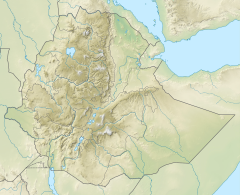Agefet
| Agefet | |
|---|---|
 The Agefet River atHazgi | |
Agefet River inDogu’a Tembien | |
| Location | |
| Country | Ethiopia |
| Region | Tigray Region |
| District (woreda) | Dogu’a Tembien |
| Physical characteristics | |
| Source | Gheralta |
| • location | 8 km east ofTsigereda |
| • elevation | 2,135 m (7,005 ft) |
| Mouth | TsalietRiver |
• location | between Addeha and Gelebeda |
• coordinates | 13°48′07″N39°06′56″E/ 13.8020°N 39.1156°E |
• elevation | 1,604 m (5,262 ft) |
| Length | 41 km (25 mi) |
| Width | |
| • average | 55 m (180 ft) |
| Basin features | |
| River system | Seasonal/permanent river |
| Landmarks | Kayeh Be’ati caves in Addi Nkrti |
| Tributaries | |
| • left | Amblo,Azef River,Ab'aro[1] |
| Waterbodies | Ginda'ireservoir |
| Bridges | on the Werqamba-Hawzienroad; on theTsigereda-Wukroroad |
| Topography | Mountains and deep gorges |
TheAgefetis a river of theNilebasin. Rising in the mountains ofGheraltain northernEthiopia,it flows westward to empty finally in theWeri’iwhich itself discharges intoTekezé River.

Characteristics
[edit]
The Agefet is a confined ephemeral river, locallymeanderingin its narrow alluvial plain, with an average slope gradient of 13 metres per kilometre. At the end of its course, it occupies a sandy pediment.[2]
Flash floods and flood buffering
[edit]Runoff mostly happens in the form of high runoff discharge events that occur in a very short period (calledflash floods). These are related to the steep topography, often little vegetation cover and intense convective rainfall. The peaks of such flash floods have often a 50 to 100 times larger discharge than the precedingbaseflow.[2] The magnitude of floods in this river has however been decreased due to interventions in the catchment. Physical conservation structures such asstone bunds[3][4]andcheck damsintercept runoff.[5][6]On many steep slopes,exclosureshave been established; the dense vegetation largely contributes to enhancedinfiltration,less flooding, and betterbaseflow.[7]
Transhumance towards the gorge
[edit]Transhumancetakes place in the summer rainy season, when the lands near the villages are occupied by crops. Young shepherds will take the village cattle down to the Agefet gorge. The gorges are particularly attractive as a transhumance destination zone, because there is water and good growth of semi-natural vegetation.[8]
Boulders and pebbles in the river bed
[edit]From upstream to downstream, the following lithological units occur in the catchment.[9]
- Phonoliteplugs
- Upper basalt
- Interbedded lacustrine deposits
- Lower basalt
- Amba Aradam Formation
- Antalo Limestone
- Quaternaryfreshwatertufa[10]
- Adigrat Sandstone
- Edaga Arbi Glacials
Logically, in the uppermost stretches of the river, only the pebbles and boulders of the upper lithological units will be present in the river bed, whereas more downstream one may find a more comprehensive mix of all lithologies crossed by the river.
Natural boundary
[edit]During its course, this river passes through three woredas (Kola Tembien,Dogu’a TembienandKilte Awula’ilo) and constitutes the border between the two latter over a dozen of kilometres.[11]
Trekking along the river
[edit]Trekking routes have been established across and along this river.[12]The tracks are not marked on the ground but can be followed using downloaded.GPX files.[13]
- TrekGh1,follows the river in its eastern course
- TrekGh2,crosses the river in its western course
In the rainy season, flash floods may occur, and it is advised not to follow the river bed. Generally, it is impossible to cross the river in the rainy season.[14]
See also
[edit]References
[edit]- ^Jacob, M. and colleagues (2019).Geo-trekking map of Dogu'a Tembien (1:50,000). In: Geo-trekking in Ethiopia's Tropical Mountains - The Dogu'a Tembien District.SpringerNature.ISBN978-3-030-04954-6.
- ^abAmanuel Zenebe, and colleagues (2019).The Giba, Tanqwa and Tsaliet rivers in the headwaters of the Tekezze basin. In: Geo-trekking in Ethiopia's Tropical Mountains - The Dogu'a Tembien District.SpringerNature.doi:10.1007/978-3-030-04955-3_14.ISBN978-3-030-04954-6.
- ^Nyssen, Jan; Poesen, Jean; Gebremichael, Desta; Vancampenhout, Karen; d'Aes, Margo; Yihdego, Gebremedhin; Govers, Gerard; Leirs, Herwig; Moeyersons, Jan; Naudts, Jozef; Haregeweyn, Nigussie; Haile, Mitiku; Deckers, Jozef (2007)."Interdisciplinary on-site evaluation of stone bunds to control soil erosion on cropland in Northern Ethiopia".Soil and Tillage Research.94(1): 151–163.doi:10.1016/j.still.2006.07.011.hdl:1854/LU-378900.
- ^Gebeyehu Taye and colleagues (2015). "Evolution of the effectiveness of stone bunds and trenches in reducing runoff and soil loss in the semi-arid Ethiopian highlands".Zeitschrift für Geomorphologie.59(4): 477–493.Bibcode:2015ZGm....59..477T.doi:10.1127/zfg/2015/0166.
- ^Nyssen, J.; Veyret-Picot, M.; Poesen, J.; Moeyersons, J.; Haile, Mitiku; Deckers, J.; Govers, G. (2004). "The effectiveness of loose rock check dams for gully control in Tigray, Northern Ethiopia".Soil Use and Management.20:55–64.doi:10.1111/j.1475-2743.2004.tb00337.x.
- ^Etefa Guyassa and colleagues (2017)."Effects of check dams on runoff characteristics along gully reaches, the case of Northern Ethiopia".Journal of Hydrology.545(1): 299–309.Bibcode:2017JHyd..545..299G.doi:10.1016/j.jhydrol.2016.12.019.hdl:1854/LU-8518957.
- ^Descheemaeker, K. and colleagues (2006)."Runoff on slopes with restoring vegetation: A case study from the Tigray highlands, Ethiopia".Journal of Hydrology.331(1–2): 219–241.doi:10.1016/j.still.2006.07.011.hdl:1854/LU-378900.
- ^Nyssen, Jan; Descheemaeker, Katrien; Zenebe, Amanuel; Poesen, Jean; Deckers, Jozef; Haile, Mitiku (2009)."Transhumance in the Tigray highlands (Ethiopia)".Mountain Research and Development.29(3): 255–264.doi:10.1659/mrd.00033.hdl:1854/LU-854326.
- ^Sembroni, A.; Molin, P.; Dramis, F. (2019).Regional geology of the Dogu'a Tembien massif. In: Geo-trekking in Ethiopia's Tropical Mountains — The Dogu'a Tembien District.SpringerNature.ISBN978-3-030-04954-6.
- ^Moeyersons, J. and colleagues (2006). "Age and backfill/overfill stratigraphy of two tufa dams, Tigray Highlands, Ethiopia: Evidence for Late Pleistocene and Holocene wet conditions".Palaeogeography, Palaeoclimatology, Palaeoecology.230(1–2): 162–178.Bibcode:2006PPP...230..165M.doi:10.1016/j.palaeo.2005.07.013.
- ^Jacob, M. and colleagues (2019).Geo-trekking map of Dogu'a Tembien (1:50,000). In: Geo-trekking in Ethiopia's Tropical Mountains - The Dogu'a Tembien District.SpringerNature.ISBN978-3-030-04954-6.
- ^Description of trekking routes in Dogu'a Tembien. In: Geo-trekking in Ethiopia's Tropical Mountains - The Dogu'a Tembien District.GeoGuide. SpringerNature. 2019.doi:10.1007/978-3-030-04955-3.ISBN978-3-030-04954-6.S2CID199294303.
- ^"Public GPS Traces tagged with nyssen-jacob-frankl".
- ^Nyssen, Jan (2019). "Logistics for the Trekker in a Rural Mountain District of Northern Ethiopia".Geo-trekking in Ethiopia's Tropical Mountains.GeoGuide. Springer-Nature. pp. 537–556.doi:10.1007/978-3-030-04955-3_37.ISBN978-3-030-04954-6.

